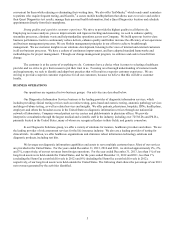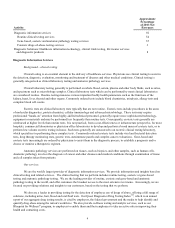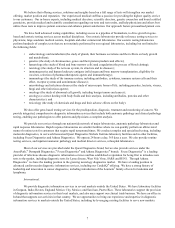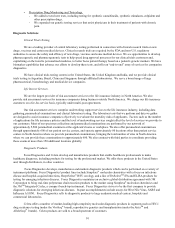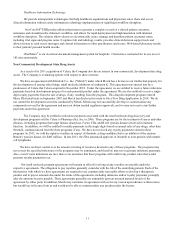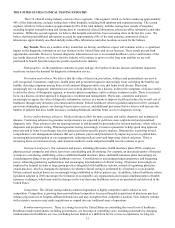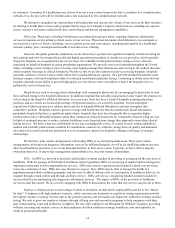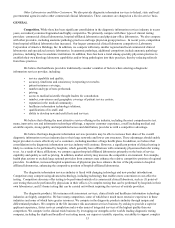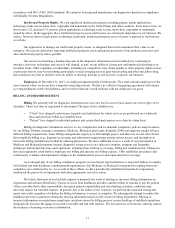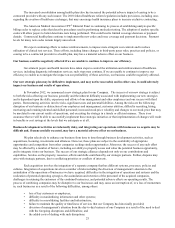Quest Diagnostics 2013 Annual Report Download - page 19
Download and view the complete annual report
Please find page 19 of the 2013 Quest Diagnostics annual report below. You can navigate through the pages in the report by either clicking on the pages listed below, or by using the keyword search tool below to find specific information within the annual report.15
Other Laboratories and Other Customers. We also provide diagnostic information services to federal, state and local
governmental agencies and to other commercial clinical laboratories. These customers are charged on a fee-for-service basis.
GENERAL
Competition. While there has been significant consolidation in the diagnostic information services industry in recent
years, our industry remains fragmented and highly competitive. We primarily compete with three types of clinical testing
providers: commercial clinical laboratories, hospital-affiliated laboratories and physician-office laboratories. We also compete
with other providers, including anatomic pathology practices and large physician group practices. In recent years, competition
from hospital-affiliated laboratories has increased. Our largest commercial clinical laboratory competitor is Laboratory
Corporation of America Holdings, Inc. In addition, we compete with many smaller regional and local commercial clinical
laboratories and specialized esoteric laboratories. In anatomic pathology, additional competitors include anatomic pathology
practices, including those in academic institutions. In addition, there has been a trend among specialty physician practices to
establish their own histology laboratory capabilities and/or bring pathologists into their practices, thereby reducing referrals
from these practices.
We believe that healthcare providers traditionally consider a number of factors when selecting a diagnostic
information services provider, including:
• service capability and quality;
• accuracy, timeliness and consistency in reporting test results;
• patient insurance coverage;
• number and type of tests performed;
• pricing;
• access to medical/scientific thought leaders for consultation;
• number, convenience and geographic coverage of patient service centers;
• reputation in the medical community;
• healthcare information technology solutions;
• qualifications of its staff; and
• ability to develop new and useful tests and services.
We believe that offering the most attractive service offering in the industry, including the most comprehensive test
menu, innovative test and information technology offerings, a superior customer experience, a staff including medical and
scientific experts, strong quality and unparalleled access and distribution, provides us with a competitive advantage.
We believe that large diagnostic information services providers may be able to increase their share of the overall
diagnostic information services industry due to their large networks and lower cost structures. These advantages should enable
larger providers to more effectively serve customers, including members of large health plans. In addition, we believe that
consolidation in the diagnostic information services industry will continue. However, a significant portion of clinical testing is
likely to continue to be performed by hospitals, which generally have affiliations with community physicians that refer testing
to us. As a result of these affiliations, we compete against hospital-affiliated laboratories primarily on the basis of service
capability and quality as well as pricing. In addition, market activity may increase the competitive environment. For example,
health plan actions to exclude large national providers from contracts may enhance the relative competitive position of regional
providers. In addition, increased hospital acquisitions of physician practices enhance the ties of the physicians to hospital-
affiliated laboratories, enhancing the competitive position of hospital-affiliated laboratories.
The diagnostic information services industry is faced with changing technology and new product introductions.
Competitors may compete using advanced technology, including technology that enables more convenient or cost-effective
testing. Competitors also may offer testing to be performed outside of a commercial clinical laboratory, such as (1) point-of-
care testing that can be performed by physicians in their offices; (2) complex testing that can be performed by hospitals in their
own laboratories; and (3) home testing that can be carried out without requiring the services of outside providers.
The diagnostic products, life insurance risk assessment services, clinical trials and healthcare information technology
industries are highly competitive. We have many competitors, some of which have much more extensive experience in these
industries and some of which have greater resources. We compete in the diagnostic products industry through unique and
differentiated products. We compete in the life insurance risk assessment services business by seeking to provide a superior
applicant experience, faster services completion and a wider array of integrated services of the highest quality than our
competitors. We compete in the clinical trials business by leveraging our strengths as the world's leading diagnostic testing
company, including the depth and breadth of our testing menu, our superior scientific expertise, our ability to support complex


